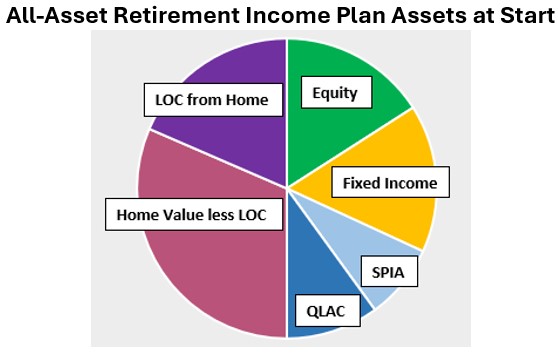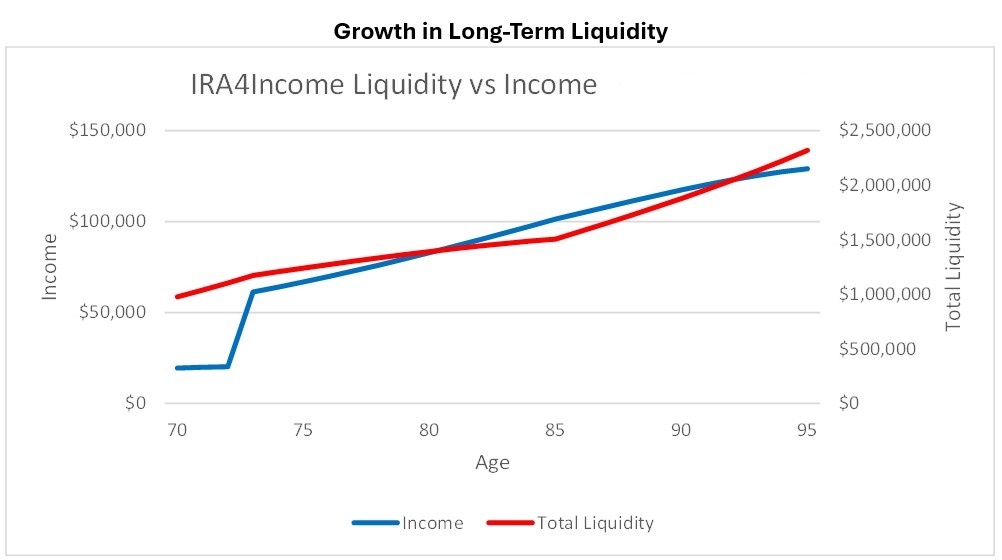How to Grow Your IRA in Retirement Rather Than Spend It Down
You really can defer RMDs and lower taxes while at the same time increasing the long-term growth of your IRA. Here's how.


Almost everyone has an IRA, 401(k) or similar retirement savings account. The purpose is to have that money available when you stop working. But what if you don’t need it right away?
This question was prompted by readers who want to know how to create options with the income from their IRA to minimize taxes and maximize liquidity — rather than merely taking the required minimum distributions (RMDs) each year. Their primary goals are about longer-term liquidity and legacy, instead of just income.
In my last article, How Combining Your Home Equity and IRA Can Supercharge Your Retirement, I wrote about how most retired families own an IRA and a home, but very few are considering how they could work together in a plan for retirement income. The retiree we frequently cite as an example — 70-year-old Sally — used the combination of her home and her IRA to generate immediate income equal to 6.5% of her $1 million in IRA savings.

Sign up for Kiplinger’s Free E-Newsletters
Profit and prosper with the best of expert advice on investing, taxes, retirement, personal finance and more - straight to your e-mail.
Profit and prosper with the best of expert advice - straight to your e-mail.
This article focuses on a version of this IRA/home combination that defers distributions and lowers taxes and at the same time increases the long-term growth in the account value, liquidity and legacy.
How an IRA/home plan meets liquidity and tax objectives
Sally’s twin sister, Susan, is concerned about costs for long-term care and other health-related events and wants to maximize liquidity so she can pay for these costs in coming years — and not be a burden for her kids. She does not own long-term care insurance.
She has several children and grandchildren and wants to leave a large legacy. In addition, she’s concerned that she may have to help with funding the grandkids’ college education. To do all of this, she needs to lower her IRA distributions and her taxes.
Susan and Sally share the same adviser, who recommends an allocation of their identical resources — $1 million in their IRAs and $1 million in the value of each of their homes — in the same set of planning components below.

Home equity can serve several functions during your retirement. Learn more about that program, called H2I, in my article How to Add Home Equity to Your Retirement Income Planning.
Susan’s objectives are different than Sally’s
- Starting income. Sally wants and needs $65,000 per year to start and to have income grow at 2% per year. Sally has LTC insurance and is paying those premiums. Susan has a higher pension and Social Security benefit. Plus, she wants to minimize taxable income and is OK with a lower starting income.
- Liquidity at age 85. Sally is OK with having $1 million in liquidity at 85; Susan wants more like $1.5 million because of her concern about the costs of health-related events and long-term care.
- Legacy at age 95. Both sisters have longevity in their genes, and Sally is OK with a $2.5 million goal at age 95; Susan wants more like $3 million for her family, which is larger.
So, with the same resources and planning components but with different retirement objectives, how do they meet retirement goals and satisfy RMD rules in both cases?
How to meet objectives and satisfy RMD rules
Well, Sally’s primary goal is high starting income, and the plan pays that out. Thus, her income will be larger than her RMDs, and no special RMD planning is required.
In Susan’s case, her goal is to minimize income and taxes, but she still has to comply with RMD rules. Her plan takes the following steps:
- Allocation to a qualifying longevity annuity contract (QLAC), which defers distributions. Susan is going to increase her QLAC from Sally’s $150,000 to the maximum of $200,000.
- Lower allocation to a single-premium immediate annuity (SPIA) since Susan doesn’t need or want the higher starting income.
- Susan plans for her IRA payouts to start at age 73, permitted under RMD rules.
- Finally, Susan’s adviser is aware of a rule adopted in the SECURE Act of 2019 that includes the market value of her SPIA in her IRA account value. Seems counterintuitive, but the new rule reduces the required withdrawals from her investment portfolios.
Defer income and minimize taxes
Susan starts with $1 million in her IRA, and she spends the maximum $200,000 to purchase a QLAC. The value of her account after the QLAC is $800,000 at the start, including her investment account value and the SPIA ($162,500). To use the combined value going forward, she will need to get the market value of the SPIA from the annuity company or an actuary.
She will not need this value until age 73, when she takes her first RMD. At that age under the plan assumptions, the total value is now $1,002,000, and the RMD is $40,600. She satisfies the RMD payment with the $13,100 SPIA payment and a smaller (than previously planned) withdrawal of $27,500 from her investment account. In addition, she is getting tax-free drawdowns from her H2I program of $20,500, and thus less than 65% of her income is taxable at age 73.
Her sister Sally’s plan is different. Sally is receiving a smaller H2I payment, starting distributions at age 70 and keeping the SPIA separate from her account value. For her, the first-year income is $65,000, over $50,000 is taxable, and more than $31,000 is coming out of her investment account.
Increase liquidity and legacy
With lower withdrawals from her investment account, Susan is on track to meet her liquidity goal of $1.5 million at age 85 (see graphic below). And her legacy nearly reached her $3 million goal. Bottom line: Susan was able to achieve her long-term objectives, and Sally was able to meet her starting income goal.

Different plans, but both sisters are happy because they achieved their respective objectives.
You can build a plan to meet your own objectives by visiting here to get started with no obligation. Consult with your own qualified adviser, find an analytical tool to provide some guidance or talk to a Go2Specialist.
Related Content
Get Kiplinger Today newsletter — free
Profit and prosper with the best of Kiplinger's advice on investing, taxes, retirement, personal finance and much more. Delivered daily. Enter your email in the box and click Sign Me Up.

Jerry Golden is the founder and CEO of Golden Retirement Advisors Inc. He specializes in helping consumers create retirement plans that provide income that cannot be outlived. Find out more at Go2income.com, where consumers can explore all types of income annuity options, anonymously and at no cost.
-
 Stock Market Today: Trump Retreats, Markets Rejoice
Stock Market Today: Trump Retreats, Markets RejoiceStocks rally, yields soften, the dollar rises, and even beaten-down names enjoy the wages of potential trade peace.
By David Dittman
-
 In Trump’s Economy Should 401(k) Savers 'Set It and Forget It?'
In Trump’s Economy Should 401(k) Savers 'Set It and Forget It?'It’s hard to bury your head in the sand when the markets are volatile. Here’s when it makes sense and when it doesn’t.
By Donna Fuscaldo
-
 Stock Market Today: Trump Retreats, Markets Rejoice
Stock Market Today: Trump Retreats, Markets RejoiceStocks rally, yields soften, the dollar rises, and even beaten-down names enjoy the wages of potential trade peace.
By David Dittman
-
 I'm 50 and My Home Is Worth $5 Million. Can I Retire Now?
I'm 50 and My Home Is Worth $5 Million. Can I Retire Now?It may be oh-so tempting to cash out your upscale home and leave work for good. But should you? We ask the experts.
By Maurie Backman
-
 Tesla Stock Pops as Elon Musk Promises DOGE Draw Back
Tesla Stock Pops as Elon Musk Promises DOGE Draw BackTesla reported a sharp drop in first-quarter earnings and sales, as the EV maker suffered a backlash to its CEO's political ambitions.
By Karee Venema
-
 Bouncing Back: New Tunes for Millennials Trying to Make It
Bouncing Back: New Tunes for Millennials Trying to Make ItAdele's mournful melodies kick off this generation's financial playlist, but with the right plan, Millennials can finish strong.
By Alvina Lo
-
 Early-Stage Startup Deals: How Do Convertible Notes Work?
Early-Stage Startup Deals: How Do Convertible Notes Work?Some angel investors support early startups by providing a loan in exchange for a convertible note, which includes annual interest and a maturity date.
By Murat Abdrakhmanov
-
 Stock Market Today: Stocks Soar on China Trade Talk Hopes
Stock Market Today: Stocks Soar on China Trade Talk HopesTreasury Secretary Bessent said current U.S.-China trade relations are unsustainable and signaled hopes for negotiations.
By Karee Venema
-
 How Can Investors Profit From AI's Energy Use?
How Can Investors Profit From AI's Energy Use?Global energy demand is expected to grow by leaps and bounds over the next several years as AI usage accelerates. Here's how to get a piece of the pie.
By Jacob Schroeder
-
 Americans Are Retiring Later: Will This Trend Last?
Americans Are Retiring Later: Will This Trend Last?Given a host of pressures to keep working, Americans are retiring later in life. Will regulatory and economic forces encourage you to work longer?
By Christy Bieber